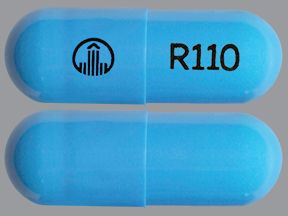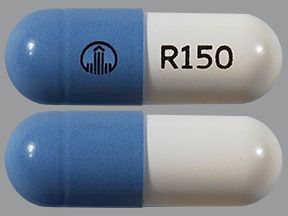Pradaxa (dabigatran etexilate) is a brand-name drug prescribed to manage certain blood clots in some adults and children. Pradaxa comes as an oral capsule. The dosage depends on the reason for taking the drug.
Pradaxa also comes as oral pellets for use in certain children. However, this article will cover information about Pradaxa capsules.
Pradaxa belongs to a drug class called anticoagulants. Specifically, it’s a type of anticoagulant called a direct thrombin inhibitor. Pradaxa is available in limited quantities as the generic drug dabigatran etexilate.
Keep reading for specific information about the dosage of Pradaxa, including its strengths and how to take the medication. For a comprehensive look at Pradaxa, see this article.
Note: This article describes typical dosages for Pradaxa provided by the drug’s manufacturer. When taking Pradaxa, always follow the dosage prescribed by your doctor.
Typically recommended dosages for Pradaxa and other details about the drug are below.
Pradaxa form
Pradaxa comes as an oral capsule. Pradaxa also comes as oral pellets for use in certain children. However, this article only covers information about Pradaxa capsules.
Pradaxa strength
Pradaxa capsule comes in the following strengths:
- 75 milligrams (mg)
- 110 mg
- 150 mg
Typical dosages
The following information describes dosages that are commonly prescribed or recommended for adults. However, be sure to take the dosage your doctor prescribes for you. They’ll determine the best dosage to fit your needs.
Dosage for reducing risks in people with AFib
Pradaxa is prescribed to reduce the risk of embolism and stroke in adults with nonvalvular atrial fibrillation (AFib). The recommended dosage for reducing these risks is 150 mg twice per day. (Nonvalvular AFib is AFib that isn’t caused by a heart valve problem.)
Dosage for preventing DVT and PE
Pradaxa is prescribed to reduce the risk of deep vein thrombosis (DVT) and pulmonary embolism (PE) in adults treated for these conditions in the past. The recommended dosage to help prevent another DVT or PE is 150 mg twice per day.
Dosage for preventing DVT and PE after hip replacement
Pradaxa is prescribed to help prevent DVT or PE in adults after hip replacement surgery. The recommended dosage is 110 mg on the day of surgery. Then, the dosage typically increases to 220 mg once per day.
Dosage for treating DVT and PE
For treating DVT and PE, Pradaxa is prescribed for adults who have received at least 5–10 days of a different anticoagulant by injection or intravenous (IV) infusion. The recommended dosage of Pradaxa for treating DVT or PE is 150 mg twice per day.
Children’s dosage
Pradaxa is approved to treat or help prevent certain types of blood clots in children ages 8–17 years. Your child’s doctor will determine their dosage based on your child’s body weight in kilograms (kg). (For reference, 1 kg is about 2.2 pounds [lb].)
The recommended dosages of Pradaxa capsules for children are as follows:
| Body weight in kg | Body weight in lb (approximate) | Twice daily dose |
| 11 kg to less than 16 kg | 24 lb to less than 35 lb | 75 mg |
| 16 kg to less than 26 kg | 35 lb to less than 57 lb | 110 mg |
| 26 kg to less than 41 kg | 57 lb to less than 90 lb | 150 mg |
| 41 kg to less than 61 kg | 90 lb to less than 134 lb | 185 mg |
| 61 kg to less than 81 kg | 134 lb to less than 178 lb | 220 mg |
| 81 kg or more | 178 lb or more | 260 mg |
Long-term treatment
Pradaxa is meant to be taken as a long-term treatment. If you and your doctor determine that Pradaxa is safe and effective for you, you’ll likely take it long term. However, some people may only need to take Pradaxa for a short period, such as after hip surgery.
Talk with your doctor about what to expect with Pradaxa treatment.
Below are some common questions about Pradaxa’s dosage.
What is the dosage of Pradaxa in older adults?
The dosage of Pradaxa for older adults (ages 65 years or older) is the same as for other adults. Pradaxa dosages vary depending on the condition your doctor is treating or helping prevent. You can find Pradaxa’s dosing information for adults in the “Pradaxa dosage” section above.
If you have questions about your Pradaxa dosage, talk with your doctor for more information.
Is there a 110-mg dose of Pradaxa?
Yes, there’s a 110-mg dose of Pradaxa. It’s the typically recommended dose after hip replacement surgery on the first day. Pradaxa is prescribed to help prevent deep vein thrombosis and pulmonary embolism after hip surgery.
Doctors also prescribe the 110-mg dose for children of a certain body weight to help prevent some types of blood clots. For details, see the “Pradaxa dosage” section above.
For questions about Pradaxa dosing, ask your doctor or pharmacist.
Can Pradaxa be used for COVID-19? If so, what’s the dose?
Yes, Pradaxa may be used off-label for COVID-19. However, the Food and Drug Administration (FDA) hasn’t approved the drug for this use. With off-label drug use, an FDA-approved drug is prescribed for a purpose other than its approved use.
If you have questions about Pradaxa for COVID-19, talk with your doctor to learn more. If your doctor recommends the drug, they’ll determine the right dosage for your condition.
Note: Pradaxa is approved by the FDA to treat or help prevent certain types of blood clots in some situations. For more information, see the “Pradaxa dosage” section above.
The Pradaxa dosage your doctor prescribes will depend on several factors. These include:
- the condition you’re taking Pradaxa to treat or help prevent
- your age
- body weight (for children)
- how well your kidneys work
Other medications you take can also affect your Pradaxa dosage.
Dosage adjustments
If you have kidney disease, your doctor may need to adjust your dosage. Before starting Pradaxa, tell your doctor if you have any type of kidney problem. They may need to check your kidney function before deciding on the right dosage.
Pradaxa comes as an oral capsule that you swallow whole. Do not chew, break, or open the capsules.
You can take Pradaxa with or without food. However, you need to take it with a full glass of water.
You’ll take Pradaxa once or twice per day, around the same times each day. If your doctor prescribes Pradaxa twice per day, try to space your doses about 12 hours apart. This helps maintain a steady level of the drug in your body so Pradaxa can work effectively.
If you have trouble swallowing capsules, see this article for tips on how to take this form of medication. You can also talk with your doctor or pharmacist.
ACCESSIBLE DRUG LABELS AND CONTAINERSSome pharmacies offer labels with large print, braille, or a code you scan with a smartphone to convert text to speech. If your local pharmacy doesn’t have these options, your doctor or pharmacist might be able to recommend a pharmacy that does.
If you’re having trouble opening medication bottles, ask your pharmacist about putting Pradaxa in an easy-open container. They also may recommend tools that can make it easier to open bottles.
If you miss a dose of Pradaxa, take it as soon as you remember. However, if your next dose is within 6 hours, skip the missed dose. Then take your next dose at the regularly scheduled time. Do not double up or take two doses at the same time. If you need help deciding whether to take a missed dose, talk with your doctor or pharmacist.
To help make sure that you don’t miss a dose, try using a medication reminder. This can include setting an alarm or using a timer. You could also download a reminder app on your phone.
It’s important that you do not take more Pradaxa than your doctor prescribes. For some medications, taking more than the recommended amount may lead to harmful effects or overdose.
If you take more than the recommended amount of Pradaxa
Call your doctor right away if you believe you’ve taken too much Pradaxa. Another option is to call America’s Poison Centers at 800-222-1222 or use its online tool. If you have severe symptoms, immediately call 911 or your local emergency number, or go to the nearest emergency room.
The dosages in this article are typical dosages provided by the drug’s manufacturer. If your doctor recommends Pradaxa for you, they’ll prescribe the dosage that’s right for you. Always follow the dosage that your doctor prescribes.
As with any drug, never change your dosage of Pradaxa without your doctor’s recommendation. If you have questions about the dosage of Pradaxa that’s best for you, talk with your doctor.
Besides learning about dosage, you may want other information about Pradaxa. These additional articles might be helpful:
- More about Pradaxa. For information about other aspects of Pradaxa, refer to this article.
- Side effects. To learn about side effects of Pradaxa, see this article. You can also look at the Pradaxa prescribing information.
- Drug comparison. Find out how Pradaxa compares with Eliquis.
- Cost. If you’d like to learn about Pradaxa and cost, see this article.
- Details about your condition. For details about your condition, see our cardiovascular health hub.
Disclaimer: Medical News Today has made every effort to make certain that all information is factually correct, comprehensive, and up to date. However, this article should not be used as a substitute for the knowledge and expertise of a licensed healthcare professional. You should always consult your doctor or another healthcare professional before taking any medication. The drug information contained herein is subject to change and is not intended to cover all possible uses, directions, precautions, warnings, drug interactions, allergic reactions, or adverse effects. The absence of warnings or other information for a given drug does not indicate that the drug or drug combination is safe, effective, or appropriate for all patients or all specific uses.


